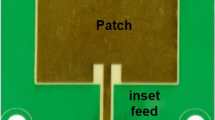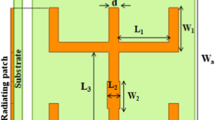Abstract
The future communication system is a fifth generation (5G) wireless communication. This communication system requires an antenna with a simple design, low traffic (high channel capacity), high gain, low cost, low power consumption (high battery life) and easy to fabricate in MMIC. The rectangular patch antenna (RPA) is a simple design, low cost, low power consumption and easy to analyze and fabricate. However, it has been affected by narrow bandwidth and single resonating frequency. That means, it has low channel capacity (high traffic) and used for the single task. These problems have been overcome by modifying the RPA. Two parallel slots have been placed on the RPA then it seems like English letter E. This modified RPA or E-shaped patch antenna (ESPA) will have the impedance bandwidth (wideband) or get a multi resonating point for enhancing channel capacity or multitask. The proposed antenna has been designed with optimized slots length and width, and position of inset fed to achieve for a wide bandwidth or a dual band with investigating the behavior of the current paths on the patch. HFSS 14V software uses to design and simulate RPA and ESPA at 28 GHz with the FR4 epoxy substrate material. Finally, the optimized proposed antenna’s results of dual-band and wideband have been resonating at frequencies of 29.12 GHz and 31.35 GHz, and impedance bandwidth 3.2 GHz respectively, and observing radiation pattern, gain and directivity are also observed.





















Similar content being viewed by others
References
Haraz, O. M., Elboushi, A., Alshebeili, S. A., & Sebak, A.-R. (2014). Dense dielectric patch array antenna with improved radiation characteristics using EBG ground structure and dielectric superstrate for future 5G cellular networks. IEEE Access,2, 909–913.
Chen, Z., & Zhang, Y. P. (2013). FR4 PCB grid array antenna for millimeter-wave 5G mobile communications. In: IEEE MTT-S, (IMWS-BIO)-workshop.
Hu, C.-N., Chang, D.-C., Yu, C.-H., Hsaio, & T.-W., Lin, D.-P. (2016). Millimeter-wave microstrip antenna array design and an adaptive algorithm for future 5G wireless communication systems. International Journal of Antennas and Propagation, 2016, Article ID 7202143.
Balanis, C. A. (1997). Antenna theory, analysis and design. New York: Wiley.
Sheik, B. A., Sridevi, P. V., & Rama Raju, P. V. (2016). Enhancement of gain and directivity in inset fed patch antenna using HFSS. IJCTA,10, 91–105.
Sheik, B. A., Sridevi, P. V., & Rama Raju, P. V. (2003). Enhancement of antenna parameters of rectangular MSA with optimized inset fed using HFSS. In: Proceedings of international conference on advanced communication systems (ICACS-2K17) (pp. 173–177), 20–22 October, 2017.
Kumar, G., & Ray, K. P. (2003). Broadband microstrip antennas. London: Artech House.
Islam, M. T., Shakib, M. N., & Misran, N. (2009). Multi-slotted microstrip patch antenna for wireless communication. Progress in Electromagnetics Research Letters,10, 11–18.
Yang, F., Zhang, X.-X., Ye, X., & Rahmat-Samii, Y. (2001). Wide-band E-shaped patch antennas for wireless communications. IEEE Transactions on Antennas and Propagation,49(7), 1094–1100.
Yu, A., & Zhang, X. (2003). A method to enhance the bandwidth of microstrip antennas using a modified E-shaped patch. In: IEEE conference (pp. 261–264).
Ge, Y., Esselle, K. P., & Bird, T. S. (2004). E-shaped patch antennas for high-speed wireless networks. IEEE Transactions on Antennas and Propagation,52(12), 3213–3219.
Noguchi, K., Rajagopalan, H., & Rahmat-Samii, Y. (2015). Design of wideband/dual-band E-shaped patch antennas with the transmission line mode theory. In: IEEE conference (pp. 1–10).
Deshmukh, A. A., Parvez, A., Lele, K, & Ray, K. P. (2017). Broadband E-shaped space-fed array with stacked e-shaped microstrip antenna array feed. In: IEEE conference.
Ang, B.-K., & Chung, B.-K. (2007). A wideband E-shaped microstrip patch antenna for 5–6 GHz wireless communications. Progress in Electromagnetics Research, PIER,75, 397–407.
Asif, S. M., Iftikhar, A., Khan, S. M., Usman, M., & Braaten, B. D. (2016). An E-shaped microstrip patch antenna for reconfigurable dual-band operation. Microwave and Optical Technology Letters,58(6), 1485–1490.
Author information
Authors and Affiliations
Corresponding author
Additional information
Publisher's Note
Springer Nature remains neutral with regard to jurisdictional claims in published maps and institutional affiliations.
Rights and permissions
About this article
Cite this article
Sheik, B.A., Sridevi, P.V. & Raju, P.V.R. E-Shaped Patch Antennas for Multitasks/Uninterrupted 5G Communications. Wireless Pers Commun 110, 873–891 (2020). https://doi.org/10.1007/s11277-019-06761-9
Published:
Issue Date:
DOI: https://doi.org/10.1007/s11277-019-06761-9




